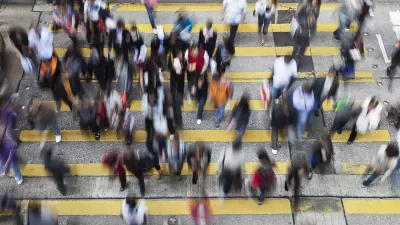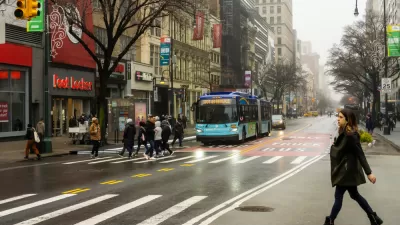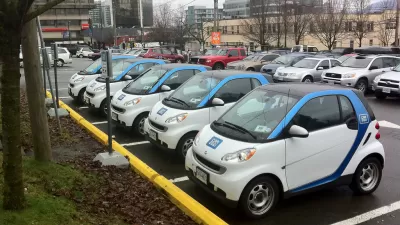A new Transit Center report shows what it takes to enact change.

According to the report, "A People’s History of Recent Urban Transportation Innovation," six cities stand out as innovators in the movement to redesign city streets for people, not cars: New York City, Portland, Chicago, Pittsburgh, Denver, and Charlotte. After half a century of building a national transportation infrastructure almost exclusively focused on accommodating automobiles, over the past decade cities across the country have shifted course, redesigning streets and public spaces for pedestrians and cyclists.
"While this may not seem 'innovative' in the technological sense, that cities would introduce bike lane networks, public plazas, mini-parks, and bikeshare wholesale onto American streets was inconceivable as recently as 2005," the report states.
How did they do it? Sandy Smith describes a three-tiered structure of roles, with citizens at the top. Citizen groups and local planning groups draw up the plans, raise public awareness and elect politicians. The relationship between the mayor’s office and constituents is critical. "By offering candidates energized blocs of voters, the advocates give politicians an opportunity to incorporate innovative thinking on urban mobility into their larger policy agendas," Smith writes.
Smith points out that the local bureaucrats tasked with implementing policies are stakeholders as well. Further, these are the people with the knowledge and savvy to design practical solution models for other cities to emulate. National movements such as the Vision Zero Network will rely on the expertise gained by local civil servants and devise broader strategies based on their successes and failures.
FULL STORY: Tracing the Urban Transportation Revolution

Planetizen Federal Action Tracker
A weekly monitor of how Trump’s orders and actions are impacting planners and planning in America.

Map: Where Senate Republicans Want to Sell Your Public Lands
For public land advocates, the Senate Republicans’ proposal to sell millions of acres of public land in the West is “the biggest fight of their careers.”

Restaurant Patios Were a Pandemic Win — Why Were They so Hard to Keep?
Social distancing requirements and changes in travel patterns prompted cities to pilot new uses for street and sidewalk space. Then it got complicated.

Platform Pilsner: Vancouver Transit Agency Releases... a Beer?
TransLink will receive a portion of every sale of the four-pack.

Toronto Weighs Cheaper Transit, Parking Hikes for Major Events
Special event rates would take effect during large festivals, sports games and concerts to ‘discourage driving, manage congestion and free up space for transit.”

Berlin to Consider Car-Free Zone Larger Than Manhattan
The area bound by the 22-mile Ringbahn would still allow 12 uses of a private automobile per year per person, and several other exemptions.
Urban Design for Planners 1: Software Tools
This six-course series explores essential urban design concepts using open source software and equips planners with the tools they need to participate fully in the urban design process.
Planning for Universal Design
Learn the tools for implementing Universal Design in planning regulations.
Heyer Gruel & Associates PA
JM Goldson LLC
Custer County Colorado
City of Camden Redevelopment Agency
City of Astoria
Transportation Research & Education Center (TREC) at Portland State University
Camden Redevelopment Agency
City of Claremont
Municipality of Princeton (NJ)




























